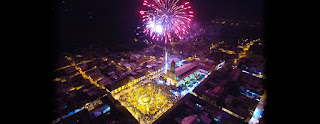Sant Miquel, capital d'una província de Cajamarca, Perú, té una església amb una forma característica i única. La construcció de l'església es va iniciar l'any 1901 i va concloure en 1912. En l'única torre, estan instal·lades antigues campanes; d'elles té inscripcions en llatí del segle XVII. La torre amb 36 metres, és la més alta de Cajamarca.
El fang o fang ha estat utilitzat com a material de construcció principal en molts llocs i èpoques. Les estructures de tova o maó de fang són durables, ja que hi ha algunes construccions de fang de fins a 10.000 anys d'antiguitat. És important que on estan aquestes construccions, hagi escassetat de pluges i molt de sol.
Els toves o maons de fang s'elaboren amb qualsevol tipus de terra, no requereixen una barreja precisa d'argila i sorra, i s'assequen al en pocs dies. La qualitat dels maons (més o menys resistència) depèn de la qualitat de la terra; és recomanable el fang amb 30% d'argila en la composició. Els materials són: Aigua, terra, palla o fibra vegetal resistent i motlles de fusta.
En Anatòlia o Àsia Menor (Turquia), a la ciutat més antiga, Çatalhöyük, 7.000 anys abans de Crist, hi havia cases construïdes amb toves. En l'Antic Egipte es va usar la tova, fet amb llim del Nil, per construir cases, tombes (mastabes), fortaleses i palaus.
En el Perú hi ha la ciutat de fang més gran d'Amèrica, la ciutadella de Chan (1200-1480), i la Ciutat Sagrada de Caral (3000 a. C. - 1800 a. C.) l'hàbitat humà més antic d'Amèrica Llatina . A Espanya es fa servir la tova en regions seques com Castella i Lleó; també en regions semidesèrtiques d'Àfrica, Amèrica Central i Amèrica del Sud.
La paraula "tova", en castellà, apareix per primera vegada entre 1139 i 1149; i prové de l'àrab al-tub (طوب), un maó sense coure, feta d'una massa de fang (argila i sorra), barrejat a vegades amb palla, modelada en forma de maó i assecada al sol.
Hi ha diverses construccions de tova notables per la grandària o per la durada, en diferents parts del món. El poble de Taos (Mèxic) ha estat habitat de manera contínua durant 1.000 anys pels indis Poble.
La Mesquita Djinguereber (Mali), construïda en 1325, perdura perquè hi ha poques pluges. La Mesquita feta de fang i palla, manté la seva forma i solidesa per l'exposició constant al sol. La Gran mesquita de Djenne (Mali) és l'edifici construït amb fang més gran del món; i encara que només té 100 anys d'antiguitat, impacta per la grandària i colorit.
Shibam, una ciutat del Iemen amb 7.000 habitants, existeix des del segle II abans de Crist. L'arquitectura amb edificis de diversos pisos, de maons de fang, separats per un laberint de carrerons estrets, li crea el sobrenom de "Manhattan del desert" o "la més antiga ciutat de gratacels del món". Hi edificis de tova amb 500 anys d'antiguitat. És Patrimoni de la Humanitat (UNESCO) des de l'any 1982.
La ciutat és l'exemple més antic de planificació urbana basada en els principis de la construcció vertical, amb un pla ben definit. Els edificis més alts arriben les 16 plantes i una alçada de fins a 40 metres; el minaret, amb 50 metres, és l'edifici més alt. Un gran programa de restauració està actualment en marxa, però el manteniment bàsic és constant per a protegir de la pluja o erosió.
Amb aquests antecedents, què té de particular l'església de Sant Miquel? Està construïda amb tova; els murs laterals estan reforçats amb contraforts. La nau principal conclou en un altar major; en el frontis hi ha tres portes amb arc. Pel material usat, per la tova, pot esperar-se que duri almenys mil anys més, mentre hi hagi pobladors que vulguin al seu poble i tinguin cura el seu patrimoni.
Tots els pobles propers a Sant Miquel tenen esglésies petites, de tova, que amb prou feines es diferencien de les construccions veïnes. Els constructors van ser entusiastes paletes, experts en construcció de cases, mes no en obres monumentals. Per què aquesta pretensió de magnificència? L'església va ser dissenyada i construïda sota la direcció d'un arquitecte, i es va projectar amb aquesta ambició per retre homenatge al patró i protector de la ciutat, Sant Miquel Arcàngel, el personatge celestial més proper a Déu i per això, per sobre de tots els sants. L'església destinada a honrar no podia ser inferior a ell.
¿Coincidència o pla perfecte? Vostès decideixin, però els que van néixer a San Miguel tenen l'orgull d'haver crescut sota l'ombra de l'església de tova més alta del Perú, i potser del món.
Encanto pueblos pequeños
Referències



































